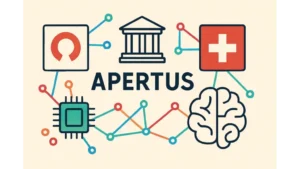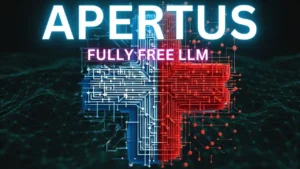Switzerland’s open AI model — a new chapter in transparent, public-interest AI
On September 2025, Switzerland took a decisive step into the center of the global AI conversation by releasing Apertus — a fully open large language model (LLM) developed by a consortium of Swiss research institutions and infrastructure partners. Unlike many high-profile models that keep weights, training code, or data pipelines behind corporate walls, Apertus is being published with its architecture, model weights, and training-data documentation openly accessible. The project positions itself as an ethical, auditable, multilingual alternative for research, education, and enterprise use — and it carries a message about technological sovereignty, legal compliance, and trust. The VergeSwisscom
What is Apertus — the headline facts
Apertus is a family of LLMs released in multiple sizes (publicly reported at 8-billion and 70-billion parameter variants) and described by the creators as intentionally fully open: the model code, training recipes, weights, and a transparent record about datasets and filtering choices are available for inspection and reuse. The initiative was led by Swiss academic and public-sector collaborators — notably ETH Zurich and EPFL — and used the Swiss National Supercomputing Centre’s (“Alps”) infrastructure for training. The release emphasized strict adherence to legal and ethical constraints: the team reports training on public data only and honoring opt-out or “no-crawl” requests where applicable. SwisscomETH ZürichThe Verge
Those basic design choices — public weights, dataset documentation, and an explicit legal/ethical framing — are what differentiate Apertus from many proprietary offerings and even from some other open-weight releases that stop short of full transparency about training data. The Swiss effort is explicitly pitched as a national and European counterpoint to Big Tech models, with the goal of offering an auditable foundation that academics, startups, and regulators can examine and build on. opendatascience.commultilingual.com
Why Switzerland? nationalism, research excellence, and infrastructure
Switzerland’s emergence in this space is not accidental. The country hosts world-class technical universities (ETH Zurich, EPFL), a strong public research culture, and supercomputing resources (CSCS’s Alps cluster) that can support large-scale model training. The Apertus project frames itself as a product of this ecosystem — an example of public infrastructure and public research producing tech that serves public goals rather than purely commercial ones. Using a national supercomputing cluster also signals a concern for technological sovereignty: countries and institutions increasingly want models that they can audit, host locally, and adapt to local regulation. ETH ZürichSwisscom
Beyond capabilities, there’s a political and philosophical posture at play. Apertus’s backers have emphasized transparency, responsibility and multilinguality as Swiss values baked into the tech. By contrast with commercial players who sometimes prioritize product speed and closed development, Apertus explicitly aligns with the idea of auditable, accountable AI built on rights-respecting data practices. That framing makes the release as much a policy statement as a technical one. Swisscommultilingual.com
What “fully open” actually means for Apertus
The term “open” gets used in different ways in AI. Apertus’s openness is notable because it claims to include:
-
Open model weights — so third parties can run, fine-tune, or audit the model. The Verge
-
Published architecture and training code/recipes — enabling reproducibility and scrutiny. opendatascience.com
-
Documentation of datasets and provenance — including statements about sourcing only public data and honoring opt-out requests where applicable. The Verge
This set of disclosures goes further than “open-weight” models that provide only weights but not dataset provenance or complete training pipelines. The Swiss team’s attempt to pair technical openness with legal and ethical guardrails is what many observers have called significant: it provides the raw materials for independent audits and also a template for how to disclose dataset choices responsibly. DeepLearning.ai
Technical highlights — multilinguality, sizes, and compute
Public reporting indicates Apertus ships in multiple parameter sizes, with headline releases at around 8B and 70B parameters. The project emphasizes multilingual support (reported support for many languages and even very small languages), aiming to avoid the English-centric bias of many models. Apertus was trained on CSCS’s “Alps” supercomputing cluster — an environment with large NVIDIA H200 GPU resources — allowing for the scale necessary to produce a competitive LLM. The Vergesherwood.news
Multilingual ambitions are particularly meaningful in the European context where many languages have limited digital training data; an open model that documents its dataset composition can help language technologists adapt and extend capabilities for regional and minority languages. The smaller 8B model also signals attention to accessibility and deployability — smaller models are cheaper to run on enterprise edge or private cloud infrastructure. multilingual.com
Legal and ethical design choices — data provenance, opt-outs, and EU norms
Apertus’s public statements have foregrounded data provenance: the team claims to have trained on publicly available datasets and followed opt-out signals (for example, respecting robots.txt or other publisher requests). This contrasts with controversies elsewhere about models trained on scraped copyrighted material. By documenting their dataset choices and publishing materials for scrutiny, the Swiss team is aiming to make the model defensible under European regulatory frameworks — both the existing copyright regime and prospective AI regulation. The VergeDeepLearning.ai
That approach aligns with a broader European push to condition AI development on legal compliance and rights protections; many enterprises facing regulatory uncertainty might find an auditable, documented model easier to adopt. However — and this is important — the legal picture remains complicated. Documenting provenance and respecting opt-outs does not automatically remove all legal risk, especially where data traces back to copyrighted or sensitive sources. Yet the Swiss team’s emphasis on transparency is practically useful: it gives lawyers, compliance officers, and civil society the information needed to judge risk. InfoWorldDeepLearning.ai
Practical uses and target audiences
Apertus is pitched as a public good: a foundation model for research, education, public sector use, and responsible commercial deployment. Key target audiences include:
-
Academic researchers who need auditable models for reproducible science. opendatascience.com
-
Startups and European enterprises that want locally hostable models with clear provenance for compliance reasons. InfoWorld
-
Language and accessibility projects aiming to improve support for smaller languages. multilingual.com
-
Regulators and civil society who require transparency to evaluate safety and fairness. DeepLearning.ai
Because Apertus provides weights and documentation, organizations can fine-tune it on private or proprietary data, deploy it behind firewalls, or use it as a starting point for domain adaptation — scenarios that are attractive where data protection or IP policy requires keeping models in-house.
How Apertus compares to other recent open model moves
The release follows a broader period where “open” and “open-weight” releases proliferated: Meta’s Llama series, China’s DeepSeek and its R1 model, and even OpenAI’s recent experiments with releasing some open-weight models. Apertus distinguishes itself by pairing full technical openness (weights + code + dataset documentation) with a legal/ethical narrative anchored in European norms. This puts it in the vanguard of projects aiming to show how public research can produce competitive models while remaining auditable. Financial TimesIt’s FOSS News
Practically, performance comparisons will matter. Large incumbents still have huge engineering teams and prodigious data assets, so Apertus’s competitiveness will be judged by benchmarks, downstream task performance, safety behavior, and cost of deployment. But for many institutional users, openness and auditability may trump a few percentage points of raw benchmark performance. It’s FOSS NewsThe Verge
Risks, limitations, and unanswered questions
No model is perfect. Apertus’s release raises several legitimate concerns and open questions:
-
Dataset completeness and hidden biases. Even with documented datasets, models inherit biases, omissions, and artifacts from their training corpora. Transparency helps identify these problems, but it does not automatically fix them. DeepLearning.ai
-
Safety and misuse. Open weights make misuse technically easier (e.g., for model-driven spam, phishing, or automation of harmful tasks). The Swiss team argues that transparency enables better oversight and mitigation, but responsible open-model governance is a complex, community task. The Verge
-
Legal gray areas. Publishing training data provenance reduces uncertainty but does not fully neutralize copyright or privacy risks in every jurisdiction. Legal scrutiny and case law will likely follow any high-profile open release. DeepLearning.ai
-
Sustainability and updates. Open projects need long-term maintenance: security patches, updates for new safety findings, and community moderation. It remains to be seen how Apertus will be sustained beyond the initial release and which governance mechanisms will steer future directions. opendatascience.com
-
Competitive reaction. Big tech players may respond with their own open offerings or with enhanced proprietary feature sets — the market reaction will shape Apertus’s adoption. Financial Times
Governance, stewardship, and the public-interest angle
One of Apertus’s most interesting features is not technical but institutional: it is an attempt to show how public research and infrastructure can create foundational AI assets that serve public interest goals. This raises a model of stewardship where universities, national labs, and non-profits play a central role in hosting and curating foundational AI infrastructure. If successful, this could become a template for other countries that want to avoid over-reliance on a narrow set of commercial providers. ETH ZürichSwisscom
For that to work, Apertus will need robust governance: transparent contribution rules, clear licensing, long-term funding for maintenance, and community norms for safety and responsible use. The Swiss institutions involved have research experience and public credibility — but scaling governance to an international user base will be a test. opendatascience.com
What to watch next
If you’re following Apertus, these are the near-term signals to track:
-
Independent audits and benchmark reports comparing Apertus to Llama, GPT variants, and DeepSeek’s models. Will Apertus match or approach the state of the art on reasoning, coding, and safety metrics? It’s FOSS NewsFinancial Times
-
Adoption by public institutions and European companies that need auditable models for compliance-sensitive deployments. InfoWorld
-
Community governance developments — license decisions, contribution processes, and any formal consortium or foundation set up to steward Apertus. Swisscom
-
Legal challenges or clarifications about dataset choices or copyright, which could set precedents for open-model releases more broadly. DeepLearning.ai
Conclusion — why Apertus matters
Apertus is important not simply because it is “another LLM,” but because it reframes what a national or public-interest model can look like: open, auditable, multilingual, and embedded in public research infrastructure. That combination addresses technical reproducibility, legal defensibility, and a politics of technological sovereignty. Even if Apertus does not immediately dethrone the biggest commercial models on every benchmark, it introduces a working blueprint for an alternative way to build and govern foundation AI systems — one rooted in transparency and public stewardship. The VergeSwisscomETH Zürich
AI Safety and Ethics: Navigating the Future of Intelligent Machines
Legal challenges against AI companies for alleged copyright infringement in training their models







